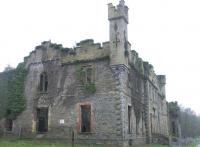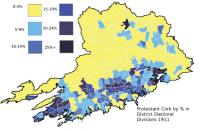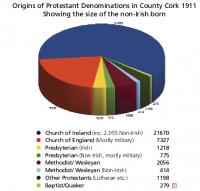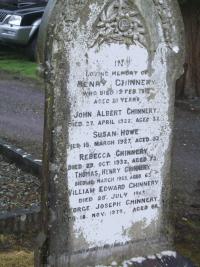Ethnic cleansing? Protestant decline in West Cork between 1911 and 1926
Published in 20th-century / Contemporary History, Features, Issue 2(March/April 2012), Revolutionary Period 1912-23, Volume 20
The ruin of Castle Bernard, once the home of the earl of Bandon, burned to the ground after he was taken hostage by the IRA before being released at the truce in July 1921.
In 1911 the Protestant population in West Cork (defined here as the seven rural districts south of the long-recognised ‘Protestant frontier’ of the Caha Mountains ridge that runs east to Cork Harbour) was 12,228. This dropped to 8,668 in 1926, a decline of 3,560 or 29.11%. If we exclude the 1,045 British military included in this figure, who left by 1922, the decline is 2,515 or 20.56%. The Roman Catholic population fell across the area by 10.58%. If the Protestant population declined at a similar rate, the ‘extra’ Protestant population loss was in the order of 9.98%.In those areas where the most serious incidents occurred, evidence of pogroms is patchy. The evidence on both sides of the argument is not contradictory, as it is clear that there was a lot less movement the farther you got from Bandon. Bantry Protestants such as Jasper Wolfe—Home Ruler, crown solicitor and later TD—were targeted for murder, or murdered, but they did not complain of any pogrom. The Protestant churches of Schull union stated that there had been no attacks on their communities two days after the murders in Dunmanway/Ballineen, yet Schull rural district lost 30% of its Protestant population, and this Protestant decline is double the equivalent Roman Catholic decline. Either the Protestant clergy downplayed their losses or they did not see them as abnormal.While 34% of the Protestant population in the Bandon rural district were lost over the fifteen years, Dunmanway, the epicentre of the April 1922 murders, suffered a decline of 19%. Clonakilty had a 37% decline, but a proportion of these were English Coastguard families, so the local Protestant figure was somewhat less. Caution must be exercised, however, as the decline between 1911 and 1926 is over a fifteen-year period, while the earlier decline is over a ten-year period. Some of the declines are small in absolute terms. Dunmanway rural district lost 14.2 Protestants per year, which equates to about 42 families in total out of around 210. In the previous ten years the figure was 14.4, representing 32 families.
 Urban West Cork
Urban West Cork
The decline was greater in the towns than in the countryside. Kinsale town stands out with its decline of 653, but virtually all of these were British military. When they are excluded, the situation is one of no native Protestant decline. Were the dramatic declines in Bandon, Bantry and Kinsale exceptional? Bandon had lost 385 Protestants between 1881 and 1891; Clonakilty exhibits a constant pattern of steep decline throughout the period; and Dunmanway’s population returned to 1881 levels. (The manuscript of the 1926 census records the precise religion and origin of each Protestant denomination, and, when eventually released, will be very revealing as regards exactly who left.)The Protestant population was generally older than the Roman Catholic. In many cases close to 20% of the population were over 60, which was substantially greater than the equivalent Roman Catholic population. In Dunmanway 4% of Roman Catholics but 13% of Protestants were over 60. There is clear shrinkage in the economic and sexually active age groups, suggesting that many of this group had already left by 1911. The Clonakilty figures are extreme. Sixty-six per cent of Catholics are under 30, while only 41% of Protestants are in this age group. Putting it bluntly, if a Church of Ireland member of prime marriageable age in Clonakilty wanted to marry within their community there were fifteen potential partners, as there were only 30 people between 20 and 30. The same is true over much of the rest of West Cork. Three stark choices presented themselves: marry a Roman Catholic, move or don’t marry.
 What happened on the ground?
What happened on the ground?
Ballygroman: O’Neill, the Hornibrooks and Woods were the first killed in this area, 10km west of Cork city. There was a 42-strong Church of Ireland community in one of the wealthiest parts of Cork. Protestant farm size was in excess of 180 acres. Eleven residents of the district electoral division (DED) were military. The total for 1901 was 69, which suggests that the decline had started long before 1911. Many of the native Protestant community remained in place despite the savage murders, but numbers had fallen to 21 by 1926. The Economic War and the lack of people to work the large farms had as much influence on the decision to sell by 1936 as the slaughter of the Hornibrooks.
Dunmanway: Dunmanway North and South DEDs lost 114 Protestants between 1911 and 1926 (25% decline). Despite the murders (see sidebar opposite), most of the population did not seem to feel under severe threat. In some of the rural areas, such as Milane DED to the west of the town, the population rose. Why? Once the 1926 manuscript is released on-line, historians will be able to make direct factual comparisons between 1911 and 1926.
Castletown–Kinneigh–Ballineen: If there was flight, it occurred here. These areas are within 5km of each other. There was a relatively small Church of Ireland community in 1911. It is significant that the Protestant population of Ballygurteen, south-west of Ballineen, drops from 61 to 46 (25%) in 1926. Ballymoney DED (including Ballineen, where Alexander McKinley was killed) drops from 199 in 1901 to 171 in 1911 (14%), and to 113 (34%) in 1926. This shows accelerated decline rather than a sudden collapse, but some must have fled from fear. Castletown (where John Chinnery lived) decreased from 90 to 71 (24%). Next door, Kinneigh (home of Robert Howe) dropped from 42 to 19 (54%) in 1926. In Teadies DED (Enniskeane) the population dropped from 174 to 145 (17%), which is relatively low, considering that it includes Killowen, the home of John Bradfield, who was the last shot on 29 April 1922 .
Clonakilty: In 1911 Robert Nagle was one of nine boys living in 38 Barrack (McCurtain) Street. He was sixteen when he was shot in lieu of his father in April 1922. It is surprising that the killers stopped at one out of ten adult males, given the possibility of revenge by the dead youth’s brothers. If the killers were out to get Protestants, why was he the only person shot in Clonakilty? Clonakilty lost 124 of its 276 Protestants in fifteen years, and this will again be a key area for analysis when the 1926 census is available. This, however, is part of a pattern that had long been established, so it is more likely to prove to have been economic, although the possiblity of flight cannot be excluded.

The gravestone of John Chinnery, one of 13 Protestant civilians murdered in and around Dunmanway in April 1922.
Bandon–Innishannon: Inishannon, to the east of Bandon, witnessed a dramatic drop from 245 to 87. The 1911 returns show that 97 people were either military, police, government or staff working for the estate houses in the area. The shooting by the IRA of ex-military men Warren Peacock, Fred Stenning and Edward Olliffe; two attacks on the RIC barracks; and the Upton ambush, involving the deaths of eight innocent civilians who got caught in the crossfire—all occurred in the parish. The five Olliffe children emigrated to the United States in two groups between August 1921 and November 1922. Between 1926 and 1936 the population rose to 101 Protestants. This suggests that there may have been some permanent and temporary migration in Inishannon. The entire DED population fell from 817 to 650 in 1926. Therefore the Protestant population fell by 158 yet nobody occupied the empty houses, as the entire population fell by 167. Bandon town’s Protestant population fell from 677 to 375, a drop of 302. The total population of the town fell by 303, which again suggests that even though there was Protestant population loss they were not replaced by anyone else.Bandon’s losses include 67 people directly connected with the barracks in the town. The Allman distillery, which was a major Protestant employer, closed in 1925. Prohibition in the United States from 1919 proved its downfall. The effect of the burning of the hosiery factory in the town in 1920 by the Black and Tans and the burning of the Allin Institute in 1921 by the IRA is not quantifiable and will require further research.The kidnapped earl of Bandon was to have been shot in 1921 in retaliation for the killing of IRA commander Seán Murphy. Republican judge Denis O’Driscoll saved him by pointing out that the earl had saved the town from burning by the British military and that he could not have ordered the Murphy killing. He was released at the truce, but his home at Castle Bernard was burned to the ground while he was in captivity. His 42 staff, mostly Church of Ireland and Presbyterian, lost their jobs.
Kinsale: The Kinsale area had a Protestant population of 2,310 in 1911. This had declined to 1,410 by 1926. The vast majority of the decline is attributable to the departure of the British garrison in the town and Charles Fort. Excluding these specific factors, the decline in the entire rural district was 92, or 4%. This is 8% less than the equivalent Roman Catholic decline. This suggests that native Protestants were moving into the area during this period rather than out. Why Kinsale should have been relatively secure requires detailed analysis once the 1926 census is released.
Individual families
The Bowen-Colthursts were a minor branch of the Colthursts of Blarney Castle (who are still in residence) and owned 930 acres of Cork in 1876. In the Great War their son Robert McGregor Bowen Colthurst, a graduate of Harrow and the vice-chamberlain to the lord lieutenant, was killed on 14 March 1915, as described by his brother-in-law, Frank West, in his diary: ‘Robbie buried opposite a cellar used as HQ by 1st Leinsters at St Eloi, N. of Armentieres’. His brother John gained infamy by murdering Francis Sheehy Skeffington and five others during the 1916 Rising. He was court-martialled and sent to Broadmoor; after his release, and pursued by the IRA, he emigrated to Canada, where he died in 1968. The Terence McSwiney papers in the Cork City and County Archives show that his family home, Dripsey Castle, was to be sold in July 1920 by his mother, Georgina Bowen-Colthurst, under some duress, but that McSwiney’s instincts were to reassure ‘late opponents’ that they could expect fair treatment by the new regime even before that regime was established.On the other hand, Maurice Stephens sold his 12,665 acres in Cork in 1895. His son Maurice only managed to buy back Castletownsend in 1914, and fled the Civil War in 1922. He returned in 1926 to find his house occupied by another family, and moved into the empty, undamaged castle in the village. He was compensated by the Free State government for the loss of his home. In both cases terrible things occurred to the family between war and revolution, but it is clear that the instinct of the new Irish government was to assure their minority that they would be treated properly in the new state.
Conclusion
The revolutionary period had a significant effect on Southern Protestants. At the start of the Great War they were facing an unpalatable devolution secure within the United Kingdom. The huge military complex in County Cork remained in place, and the imperial parliament still reigned supreme. Seven years later these assumptions had been swept aside by the storm created by 1916. Some of their community had been shot, others had been burned out, while others had been forced out of the country. Nevertheless, most native Cork Protestants remained.There is little evidence that there was a coordinated campaign of murder and intimidation against Protestants in the area; nevertheless, the Protestant population of West Cork declined by approximately 1,200 people over the fifteen-year period for non-economic reasons. These include the impact of the Great War, influenza, the change of administration, Ne Temere and, of course, fear. Given what happened in Ireland between 1911 and 1926, the surprise is not how many native Protestants left but how many remained. Perhaps those involved on both sides of the ongoing historiographical controversy would join together in seeking the publication of the manuscript of the 1926 census as a matter of urgency to establish certainty in place of speculation. HI
Barry Keane teaches history and geography in Cork.
Further reading:
P. Hart, The IRA and its enemies (Oxford, 1998).N. Meehan, Troubled history: a tenth anniversary critique of Peter Hart’s The IRA and its enemies (Dublin, 2008).J. White, Minority report: the Protestant community in the Irish Republic (Dublin, 1975).
















